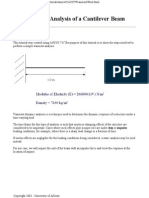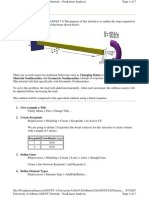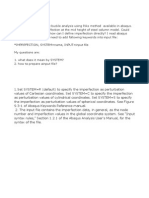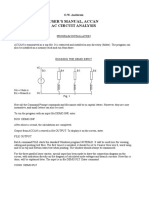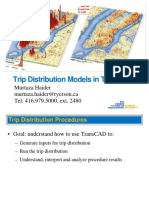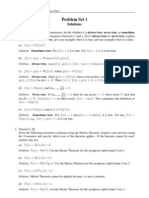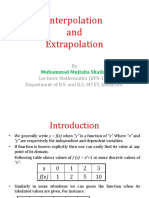Buckling Analysis
Buckling Analysis
Uploaded by
anthraxpCopyright:
Available Formats
Buckling Analysis
Buckling Analysis
Uploaded by
anthraxpCopyright
Available Formats
Share this document
Did you find this document useful?
Is this content inappropriate?
Copyright:
Available Formats
Buckling Analysis
Buckling Analysis
Uploaded by
anthraxpCopyright:
Available Formats
University of Alberta ANSYS Tutorials - www.mece.ualberta.ca/tutorials/ansys/CL/CIT/Buckling/Print.
html
Buckling
Introduction
This tutorial was created using ANSYS 7.0 to solve a simple buckling problem.
It is recommended that you complete the NonLinear Tutorial prior to beginning this tutorial
Buckling loads are critical loads where certain types of structures become unstable. Each load has an associated
buckled mode shape; this is the shape that the structure assumes in a buckled condition. There are two primary
means to perform a buckling analysis:
1. Eigenvalue
Eigenvalue buckling analysis predicts the theoretical buckling strength of an ideal elastic structure. It
computes the structural eigenvalues for the given system loading and constraints. This is known as
classical Euler buckling analysis. Buckling loads for several configurations are readily available from
tabulated solutions. However, in real-life, structural imperfections and nonlinearities prevent most real-
world structures from reaching their eigenvalue predicted buckling strength; ie. it over-predicts the
expected buckling loads. This method is not recommended for accurate, real-world buckling prediction
analysis.
2. Nonlinear
Nonlinear buckling analysis is more accurate than eigenvalue analysis because it employs non-linear,
large-deflection, static analysis to predict buckling loads. Its mode of operation is very simple: it
gradually increases the applied load until a load level is found whereby the structure becomes unstable
(ie. suddenly a very small increase in the load will cause very large deflections). The true non-linear
nature of this analysis thus permits the modeling of geometric imperfections, load perterbations, material
nonlinearities and gaps. For this type of analysis, note that small off-axis loads are necessary to initiate
the desired buckling mode.
Copyright © 2002 University of Alberta
University of Alberta ANSYS Tutorials - www.mece.ualberta.ca/tutorials/ansys/CL/CIT/Buckling/Print.html
This tutorial will use a steel beam with a 10 mm X 10 mm cross section, rigidly constrained at the bottom. The
required load to cause buckling, applied at the top-center of the beam, will be calculated.
ANSYS Command Listing
Eigenvalue Buckling
FINISH ! These two commands clear current data
/CLEAR
/TITLE,Eigenvalue Buckling Analysis
/PREP7 ! Enter the preprocessor
ET,1,BEAM3 ! Define the element of the beam to be buckled
R,1,100,833.333,10 ! Real Consts: type 1, area (mm^2), I (mm^4), height (mm)
MP,EX,1,200000 ! Young's modulus (in MPa)
MP,PRXY,1,0.3 ! Poisson's ratio
K,1,0,0 ! Define the geometry of beam (100 mm high)
K,2,0,100
L,1,2 ! Draw the line
ESIZE,10 ! Set element size to 1 mm
LMESH,ALL,ALL ! Mesh the line
FINISH
/SOLU ! Enter the solution mode
Copyright © 2002 University of Alberta
University of Alberta ANSYS Tutorials - www.mece.ualberta.ca/tutorials/ansys/CL/CIT/Buckling/Print.html
ANTYPE,STATIC ! Before you can do a buckling analysis, ANSYS
! needs the info from a static analysis
PSTRES,ON ! Prestress can be accounted for - required
! during buckling analysis
DK,1,ALL ! Constrain the bottom of beam
FK,2,FY,-1 ! Load the top vertically with a unit load.
! This is done so the eigenvalue calculated
! will be the actual buckling load, since
! all loads are scaled during the analysis.
SOLVE
FINISH
/SOLU ! Enter the solution mode again to solve buckling
ANTYPE,BUCKLE ! Buckling analysis
BUCOPT,LANB,1 ! Buckling options - subspace, one mode
SOLVE
FINISH
/SOLU ! Re-enter solution mode to expand info - necessary
EXPASS,ON ! An expantion pass will be performed
MXPAND,1 ! Specifies the number of modes to expand
SOLVE
FINISH
/POST1 ! Enter post-processor
SET,LIST ! List eigenvalue solution - Time/Freq listing is the
! force required for buckling (in N for this case).
SET,LAST ! Read in data for the desired mode
PLDISP ! Plots the deflected shape
NonLinear Buckling
FINISH ! These two commands clear current data
/CLEAR
/TITLE, Nonlinear Buckling Analysis
/PREP7 ! Enter the preprocessor
ET,1,BEAM3 ! Define element as beam3
MP,EX,1,200000 ! Young's modulus (in Pa)
MP,PRXY,1,0.3 ! Poisson's ratio
R,1,100,833.333,10 ! area, I, height
K,1,0,0,0 ! Lower node
K,2,0,100,0 ! Upper node (100 mm high)
L,1,2 ! Draws line
ESIZE,1 ! Sets element size to 1 mm
LMESH,ALL ! Mesh line
FINISH
/SOLU
ANTYPE,STATIC ! Static analysis (not buckling)
NLGEOM,ON ! Non-linear geometry solution supported
OUTRES,ALL,ALL ! Stores bunches of output
Copyright © 2002 University of Alberta
University of Alberta ANSYS Tutorials - www.mece.ualberta.ca/tutorials/ansys/CL/CIT/Buckling/Print.html
NSUBST,20 ! Load broken into 5 load steps
NEQIT,1000 ! Use 20 load steps to find solution
AUTOTS,ON ! Auto time stepping
LNSRCH,ON
/ESHAPE,1 ! Plots the beam as a volume rather than line
DK,1,ALL,0 ! Constrain bottom
FK,2,FY,-50000 ! Apply load slightly greater than predicted
! required buckling load to upper node
FK,2,FX,-250 ! Add a horizontal load (0.5% FY) to initiate
! buckling
SOLVE
FINISH
/POST26 ! Time history post processor
RFORCE,2,1,F,Y ! Reads force data in variable 2
NSOL,3,2,U,Y ! Reads y-deflection data into var 3
XVAR,2 ! Make variable 2 the x-axis
PLVAR,3 ! Plots variable 3 on y-axis
/AXLAB,Y,DEFLECTION ! Changes y label
/AXLAB,X,LOAD ! Changes X label
/REPLOT
Copyright © 2002 University of Alberta
You might also like
- Week 17 STI52 TNT Converting Pressures To Nodal Forces PDFDocument4 pagesWeek 17 STI52 TNT Converting Pressures To Nodal Forces PDFMiguel F SalamancaNo ratings yet
- Its Class 8 Optional Maths Model Question Paper 1Document2 pagesIts Class 8 Optional Maths Model Question Paper 1Dhana Aryal80% (5)
- UA NonLinDocument2 pagesUA NonLinlinus.ge3477No ratings yet
- TB, MelaDocument2 pagesTB, MelaAndreaAlberoNo ratings yet
- Two Dimensional TrussDocument2 pagesTwo Dimensional Trussgreat2007No ratings yet
- Truss FileDocument2 pagesTruss FileSlim SalimNo ratings yet
- Plane Stress Bracket: Verification ExampleDocument2 pagesPlane Stress Bracket: Verification ExampleRoberto CastilloNo ratings yet
- Modeling Using AxisymmetryDocument2 pagesModeling Using AxisymmetryNagamani ArumugamNo ratings yet
- Trasient Analysisi of Cantiveler BeamDocument4 pagesTrasient Analysisi of Cantiveler BeamWireman SusantoNo ratings yet
- Structural Analysis GuideDocument13 pagesStructural Analysis GuideMadhusudhanan ChelliahNo ratings yet
- Ansys APDLDocument3 pagesAnsys APDLradheNo ratings yet
- Week5 Surface Effect Elements PDFDocument7 pagesWeek5 Surface Effect Elements PDFsvk_ntNo ratings yet
- Design OptimizationDocument2 pagesDesign OptimizationKarthikeyan VeeraNo ratings yet
- Mesh Convergence Study Using ANSYSDocument2 pagesMesh Convergence Study Using ANSYSEric Borg SaywellNo ratings yet
- 6.4. Example Spectrum Analysis (Command or Batc Method)Document2 pages6.4. Example Spectrum Analysis (Command or Batc Method)Kapil NandwanaNo ratings yet
- How Linear FEA Helps in FatigueDocument7 pagesHow Linear FEA Helps in FatigueShuchi GuptaNo ratings yet
- Material Nonlinearities and Geometric Nonlinearities (Change in Response Due To Large Deformations)Document7 pagesMaterial Nonlinearities and Geometric Nonlinearities (Change in Response Due To Large Deformations)api-3833671No ratings yet
- Pre-Buckled Shape in Nonlinear BucklingDocument9 pagesPre-Buckled Shape in Nonlinear BucklingJianbei ZhuNo ratings yet
- linearDocument1 pagelinearhuy.phungakanomercyNo ratings yet
- Lecture 1 - Structural Mechanics - Design and Analysis With FEMDocument59 pagesLecture 1 - Structural Mechanics - Design and Analysis With FEMminhtran1986vnNo ratings yet
- Chapter 16: Aerospace Spectrum File Support MSC Fatigue 2005 Quickstart GuideDocument8 pagesChapter 16: Aerospace Spectrum File Support MSC Fatigue 2005 Quickstart GuideHumayun NawazNo ratings yet
- Advanced X-Sectional Plane StressDocument2 pagesAdvanced X-Sectional Plane StressndeminNo ratings yet
- 1) Structural Symmetry 2) Bookshelf Problem: Jake Blanchard Fall 2009Document8 pages1) Structural Symmetry 2) Bookshelf Problem: Jake Blanchard Fall 2009abyvavaNo ratings yet
- Beam Workshop Using Ansys V12Document10 pagesBeam Workshop Using Ansys V12RoyNo ratings yet
- ANSYS-3D Space Frame ExampleDocument4 pagesANSYS-3D Space Frame Examplejeeva_maestroNo ratings yet
- 3D Space Frame Example: Problem DescriptionDocument4 pages3D Space Frame Example: Problem DescriptionuismechprojectNo ratings yet
- Stressing A Plate With A Circular or Elliptical HoleDocument4 pagesStressing A Plate With A Circular or Elliptical HoleAlex da SilvaNo ratings yet
- Version 2Document52 pagesVersion 2LUIS DAVID MOROCHO POGONo ratings yet
- ANSYS NonLinear Analysis EPT FEB08Document38 pagesANSYS NonLinear Analysis EPT FEB08manel_drNo ratings yet
- Electronic Structure VASP DIAMONDDocument11 pagesElectronic Structure VASP DIAMONDRajasekarakumar Vadapoo50% (2)
- Cantiliver Nonlinear AnalysisDocument7 pagesCantiliver Nonlinear AnalysismrdesperateNo ratings yet
- University of Alberta ANSYS Tutorials - NonLinear AnalysisDocument6 pagesUniversity of Alberta ANSYS Tutorials - NonLinear AnalysisRithesh Baliga BNo ratings yet
- Tutorials - Nonlinear & Eigenvalue Buckling ProblemDocument20 pagesTutorials - Nonlinear & Eigenvalue Buckling Problemmanuel_9_4No ratings yet
- Application of Joints and Springs in ANSYSDocument3 pagesApplication of Joints and Springs in ANSYSmaior64No ratings yet
- FE2015 APDL1 Frame SDocument9 pagesFE2015 APDL1 Frame SnitaidNo ratings yet
- LabInstr EE320L Lab9Document8 pagesLabInstr EE320L Lab9MjdNo ratings yet
- Mechanical APDL Low-Frequency Electromagnetic Analysis GuideDocument5 pagesMechanical APDL Low-Frequency Electromagnetic Analysis GuideEdjavier CastilloNo ratings yet
- Me 8711 Lab Manual LmcetDocument64 pagesMe 8711 Lab Manual LmcetGODWIN GNo ratings yet
- University of AlbertaDocument2 pagesUniversity of AlbertaasimkamalNo ratings yet
- ANSYS ClassicDocument4 pagesANSYS Classicmicael_89No ratings yet
- Vasp Lab1 IntroDocument6 pagesVasp Lab1 IntroSam RoelantsNo ratings yet
- ImperfectionsDocument10 pagesImperfectionsDiego Patteri100% (1)
- EE133 - Prelab 2 Using Oscillators To Generate FM Signals: Transmitter ReceiverDocument8 pagesEE133 - Prelab 2 Using Oscillators To Generate FM Signals: Transmitter ReceiverIhsan MalikNo ratings yet
- Buckling Analysis: The Theory of BucklingDocument6 pagesBuckling Analysis: The Theory of BucklingKing Everest100% (2)
- FYSMENA4111 Computer Lab 5 SurfacesDocument5 pagesFYSMENA4111 Computer Lab 5 Surfaceswer809No ratings yet
- User'S Manual, Accan Ac Circuit Analysis: O.W. AndersenDocument22 pagesUser'S Manual, Accan Ac Circuit Analysis: O.W. AndersenguestNo ratings yet
- Sti0806 - UseroutDocument7 pagesSti0806 - UseroutVenkata Surya N SingampalliNo ratings yet
- Dhruv IlDocument8 pagesDhruv IlVasu MangukiyaNo ratings yet
- Uniaxial Tension - EVOCDDocument7 pagesUniaxial Tension - EVOCDanon_637246413No ratings yet
- Derivatives 2Document41 pagesDerivatives 2bbaytlNo ratings yet
- IntroductionDocument1 pageIntroductionShrikant KarandikarNo ratings yet
- ME8711 Simulation and Analysis LaboratoryDocument62 pagesME8711 Simulation and Analysis Laboratory1newlight1No ratings yet
- Department of Mechanical Engineering: Laboratory ManualDocument52 pagesDepartment of Mechanical Engineering: Laboratory ManualMECHANICAL SMCETNo ratings yet
- Department of Mechanical Engineering: Laboratory ManualDocument52 pagesDepartment of Mechanical Engineering: Laboratory ManualMECHANICAL SMCETNo ratings yet
- STEM: Science, Technology, Engineering and Maths Principles Teachers Pack V10From EverandSTEM: Science, Technology, Engineering and Maths Principles Teachers Pack V10No ratings yet
- Spectral method for fatigue damage estimation with non-zero mean stressFrom EverandSpectral method for fatigue damage estimation with non-zero mean stressNo ratings yet
- Standard-Slope Integration: A New Approach to Numerical IntegrationFrom EverandStandard-Slope Integration: A New Approach to Numerical IntegrationNo ratings yet
- Christmas Coloring BookDocument77 pagesChristmas Coloring Bookanthraxp100% (1)
- Touran GP II DimensionsDocument2 pagesTouran GP II DimensionsanthraxpNo ratings yet
- Fy16 IKEA Coloring PagesDocument5 pagesFy16 IKEA Coloring PagesanthraxpNo ratings yet
- High Performance Linear Algebra Class Reference Guide April 1996Document19 pagesHigh Performance Linear Algebra Class Reference Guide April 1996anthraxpNo ratings yet
- Bhatti ADocument19 pagesBhatti AanthraxpNo ratings yet
- CQF January 2014 Maths Primer Calculus ExercisesDocument2 pagesCQF January 2014 Maths Primer Calculus ExercisesShravan VenkataramanNo ratings yet
- Wave Equation in 1D (Part 1)Document19 pagesWave Equation in 1D (Part 1)baraa AlkhaqaniNo ratings yet
- Complex Numbers L2 NotesDocument117 pagesComplex Numbers L2 NotesudayadityasuryamNo ratings yet
- Theoretical Analysis of Non-Probabilistic Reliability Based On Interval ModelDocument9 pagesTheoretical Analysis of Non-Probabilistic Reliability Based On Interval ModelDanielaAndreaRoldanNo ratings yet
- Generalized Isocline Method of Plotting Phase-Plane TrajectoriesDocument4 pagesGeneralized Isocline Method of Plotting Phase-Plane TrajectoriesAtanuMajiNo ratings yet
- 3 Model Matematik SistemDocument34 pages3 Model Matematik SistemVincent koNo ratings yet
- Syllabus CS409Document2 pagesSyllabus CS409ammadip465No ratings yet
- A. Cylindrical Coordinates: Ao AzDocument33 pagesA. Cylindrical Coordinates: Ao AzekaNo ratings yet
- Maths Formula Part 1Document25 pagesMaths Formula Part 1yamini.tasareNo ratings yet
- Tseng 2004 Mechanism and Machine TheoryDocument15 pagesTseng 2004 Mechanism and Machine TheoryKhanh VqNo ratings yet
- Trip Distribution Models TransCAD-1Document34 pagesTrip Distribution Models TransCAD-1NabeelSaleemNo ratings yet
- Engineering Question PapersDocument3 pagesEngineering Question Papersmanmohan kNo ratings yet
- Suggested Solution To Assignment 1 - MATH4220Document10 pagesSuggested Solution To Assignment 1 - MATH4220Ben WiswellNo ratings yet
- Lab 4Document2 pagesLab 4周泰No ratings yet
- Mathematics Computational Msthrmstics MA1101 - Tutorial2 Contact Naresh Sehdev 8527018189Document2 pagesMathematics Computational Msthrmstics MA1101 - Tutorial2 Contact Naresh Sehdev 8527018189Naresh SehdevNo ratings yet
- Quadratics Scavenger HuntsDocument12 pagesQuadratics Scavenger HuntsYani CastroNo ratings yet
- CF 1Document2 pagesCF 1albertli190515No ratings yet
- Numerical DifferentiationDocument6 pagesNumerical DifferentiationrodrigojNo ratings yet
- Stat MechDocument270 pagesStat MechRithish Barath100% (1)
- SLC - OPT Math - PolynomialsDocument0 pagesSLC - OPT Math - Polynomialswww.bhawesh.com.npNo ratings yet
- Week 3 MathDocument6 pagesWeek 3 MathRosette RoblesNo ratings yet
- Chapter 2 SolutionsDocument134 pagesChapter 2 Solutionsapi-209868636No ratings yet
- Ps 1 SolDocument3 pagesPs 1 SolPang XsNo ratings yet
- A Primer For MATLAB Tutorial and Documentation For Auburn University Chemical Engineering StudentsDocument29 pagesA Primer For MATLAB Tutorial and Documentation For Auburn University Chemical Engineering Studentsbarbara_ropeNo ratings yet
- Improved Euler Method & Modified Euler Method (Second Order Runge Kutta Method) Requirements: Geometrical Interpretation of DerivativeDocument12 pagesImproved Euler Method & Modified Euler Method (Second Order Runge Kutta Method) Requirements: Geometrical Interpretation of DerivativeBikiNo ratings yet
- Vikash Math Paper 1Document5 pagesVikash Math Paper 1surajsharmabuNo ratings yet
- Interpolation, Extrapolations and Difference OperatorsDocument16 pagesInterpolation, Extrapolations and Difference Operatorsabdul latif100% (1)
- MATH 2111 - Matrix Algebra and ApplicationsDocument37 pagesMATH 2111 - Matrix Algebra and ApplicationsLinh TaNo ratings yet
- Apostila - Cálculo Ii - Aplicações Da Integral - IiDocument12 pagesApostila - Cálculo Ii - Aplicações Da Integral - IiLuciano SantosNo ratings yet








